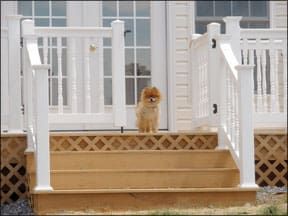Occasionally I’ll get a call from a client who is having trouble getting their dog to go up or down stairs – a frustrating dilemma when you want your canine companion to be able to accompany you wherever you go. First, be sure your stairs are covered with a traction-providing surface, so he doesn’t slip and scare himself if he tries to use them. Next, here are some tips for overcoming this challenge:

288
1. Get a veterinary/chiropractic check-up. If your dog is hurting or otherwise physically challenged, it may be too painful or difficult for him to negotiate stairs. A chiropractic adjustment and/or pain-relief medications may have him scampering up and down in no time. If the condition cannot be alleviated enough to make him able to do stairs, you’ll know it’s time to stop trying, and find another alternative.
2. Carry him. Some small dogs (like our Pomeranian, Scooter) just aren’t big enough to handle a full flight of stairs. Scooter can manage the two steps at the back door into the house, but not the full flight of stairs up to our bedroom, so I carry him up at night, and back down in the morning. If you have a small dog who doesn’t like to be carried, you can teach him to go into a carrier, and tote the carrier up and down the stairs. You can also carry or use a carrier for a medium-sized dog who, for whatever reason, doesn’t like stairs, but it’s not a good option for a dog who is too large for easy lifting!
3. Provide an alternative. When we added a sunroom and new deck to the back of our house, my husband had the foresight to ask the contractor to build a ramp in addition to stairs, in anticipation of aging canines who might have difficulty with stairs. A few months later we adopted Scooter, who delights in using the ramp to the deck rather than the stairs. If your geriatric guy is having trouble and a ramp isn’t an option, you can use a towel as a sling under his abdomen to assist his back end up the stairs. This one’s a stretch, but if you happen to live in a home that has a stair-elevator chair for a disabled person, teach him to use that!
4. Shape it. Your dog may simply be afraid to go up and down stairs, and the more you pressure him to do it, the scarier it feels to him. Shaping allows the dog to make his own decisions and reinforces him for tiny pieces of “stair behavior” so he gains confidence. Just start at one end of the stairway – top or bottom, wherever he’s more comfortable – and click (or use a verbal marker) and give him a treat for any small movement toward the stairs. No coaxing, no luring, just let him make all the decisions and all the moves. In time – faster for some dogs, slower for others, your dog will take one step up (or down) then another, then another, and finally be happily willing to do the entire flight. If you’ve done other shaping games with your dog this may go faster; if you and your canine pal are new to shaping this can take longer. (See “The Shape of Things to Come,” WDJ March 2006.)
5. Back chain it. This is another solution for tiny to medium dogs – not practical for large dogs, but it can work like a charm with smaller ones.
Instead of starting at the bottom step and working your way up (or vice-versa), carry your dog up the stairs and set him down one step from the top. He sees safety just one step up and makes the attempt – one step is manageable for him, even if he’s afraid of stairs – and goes for the top. Phew! He made it! Feed him yummy treats too, as added reinforcement for his superb effort.
Repeat that process just one step from safety until he does that happily and easily, then set him two steps from the top. Emboldened by his repeated success with one step, he’s able to make the effort for two steps, then three, then four, until he can easily go up and down the entire flight without concern. Happy stair climbing!
Pat Miller, CPDT-KA, CDBC, is WDJ’s Training Editor. Miller lives in Fairplay, Maryland, site of her Peaceable Paws training center. Pat is also author of several books on positive training, including her latest: Do Over Dogs: Give Your Dog a Second Chance for a First Class Life.






